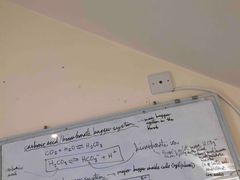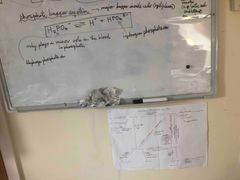![]()
![]()
![]()
Use LEFT and RIGHT arrow keys to navigate between flashcards;
Use UP and DOWN arrow keys to flip the card;
H to show hint;
A reads text to speech;
35 Cards in this Set
- Front
- Back
|
Detail the carbonic acid - bicarbonate buffer system? |

Back (Definition) |
|
|
Detail the phosphate buffer system? |

Back (Definition) |
|
|
What is the bacteria cell wall made out of and what is the significance of this? |
Murein cell wall -> consists of sugars and amino acids (nitrogen-containing compound) • the cell wall maintains the cell shape and prevents the cell bursting under osmotic pressure |
|
|
What is the fungi cell wall made out of and what is the significance of this? |
Chitin -> mainly polysaccharides (carbon-containing substance) |
|
|
Insect exoskeletons are made of? |
Chitin (Carbon-containing substance) |
|
|
Insect exoskeletons are made of? |
Chitin (Carbon-containing substance) • NB - there are loads of hydrogen bonds between polymer chains which gives it increased strength |
|
|
What do insect cuticles (exoskeletons) contain? |
• chitin • structural proteins (CPs) -> these are hypothesised to be cross-linked with other CPs and to chitin -> providing rigidity but also leightweight |
|
|
Above and beyond: Cycles in biology |
• buffers -> carbonic acid- bicarbonate system |
|
|
Break down ‘write an essay about cycles in Biology’ into different big aspects. |
• environmental cycles • cellular cycles • physiological cycles |
|
|
Break down ‘write an essay about cycles in Biology’ into different big aspects. |
• environmental cycles • cellular cycles • physical cycles |
|
|
What is your enzyme beyond the spec material? |
• Aspartoacylase • catalyses the deacetylation of NAA -> metabolising it in the brain • this metabolisation is important for the formation of myelin lipids • defects in this enzyme (mutation) lead to the build up of NAA in the brain • eventually causes a fatal neurological disorder -> canavan disease |
|
|
What is the cell membrane of fungi made of? |
Mainly phospholipid |
|
|
What are chemosynthetic bacteria? |
Oxidise inorganic molecules (usually H2S) and use the energy released to produce organic compounds (e.g. sugars). Like photosynthesis with no light required. O2 + H2S + CO2 + H2O -> sugar + H2SO4 • often live in deep ocean where there is no light. Often H2S is produced here in hydrothermal vents. |
|
|
What is Cytochrome c oxidase? What does it do? |
Is the final enzyme in the electron transport chain (oxidative phosphorylation) of all Eukaryotes. -> this means you can use it in Fungi examples! • it is embedded in the inner mitochondrial membrane • transfers electrons to the O2 molecule (reducing it) and combines it with H+ ions to form water molecules. |
|
|
What is Cytochrome c oxidase? What does it do? |
Is the final enzyme in the electron transport chain (oxidative phosphorylation) of all Eukaryotes. -> this means you can use it in Fungi examples! • it is embedded in the inner mitochondrial membrane • Binds O2 between a copper and an iron ion. Then transfers electrons to the O2 molecule (reducing it) and combines it with H+ ions to form water molecules. |
|
|
The polymers in murein are linked together by...? |
Peptide bridges. |
|
|
Outline how the formation of a blood clot after an injury is an example of negative feedback? |
• During blood clot formation, platelets are activated • activated platelets release a chemical. This chemical activated more platelets. Leading to even more blood clotting. • Fast blood clot • importance: protection from infection |
|
|
Octopi can edit their RNA to increase their proteome without increasing the size of their genome. This can help them rapidly adapt to temporary changes in environment, however slows down their evolution. What enzymes do the editing? |
ADAR enzymes |
|
|
What are the receptors called in temperature negative feedback? Where are they found? |
Thermoreceptors (in the skin) |
|
|
What are ligand-gated ion channels? |
• the protein channels on post-synaptic neurones that allow ions (e.g. Na+, K+, Ca2+, and Cl-) to pass through the membrane • the channels open in response to binding of a ligand (such as a neurotransmitter) at the ligand binding site |
|
|
Ligand gated ion channels could be important in questions on ‘the importance of specific shapes in molecules’ |
• |
|
|
What is meant by - control? |
The power to influence or direct the course of events. |
|
|
You always think about the enzymes that are involved in transcription (e.g. DNA helicase and RNA polymerase). Don’t forget about the enzymes involved in translation -> ribozymes |
• |
|
|
Parasitoid wasp |
A group of wasps that lay their eggs in the body of spiders, beetles and caterpillars. |
|
|
Parasitoid wasp |
A group of wasps that lay their eggs in the body of spiders, beetles and caterpillars. • the larvae eat themselves out, eventually killing the host. |
|
|
Lipids can aid the function of enzymes. Give an example. |
• Cardiolipin (found in all eukaryotes, in the ETC of ox. phos. of aerobic respiration) • cytochrome bc1 needs cardiolipin associated with it in order to maintain its quaternary structure so that it can function correctly -> cytochrome bc1 reduces cytochrome c in the ETC |
|
|
Lipids can aid the function of enzymes. Give an example. |
• Cardiolipin (found in all eukaryotes, in the ETC of ox. phos. of aerobic respiration) • cytochrome bc1 (an enzyme) needs cardiolipin associated with it in order to maintain its quaternary structure so that it can function correctly -> cytochrome bc1 reduces cytochrome c in the ETC |
|
|
Lipids can aid the function of enzymes. Give an example. |
• Cardiolipin (found in all eukaryotes, in the ETC of ox. phos. of aerobic respiration) (and in the membranes of most bacteria) • cytochrome bc1 (an enzyme) needs cardiolipin associated with it in order to maintain its quaternary structure so that it can function correctly -> cytochrome bc1 reduces cytochrome c in the ETC |
|
|
Fat under the skin is called? |
Subcutaneous fat |
|
|
How are fats used in drug delivery and gene therapy? |
• liposomes (spheres of lipids) • composed of phospholipids (bilayer structure) • contain an aqueous core -> hydrophilic substances can be contained • the liposomes fuses with cell membranes releasing its contents into the cell |
|
|
What topics could we get diabetic ketoacidosis into? |
• lipids can be metabolised (respired) to release energy -> which is good but can be bad • diabetes -> the importance of insulin (proteins) (hormones) • the importance of maintaining blood pH |
|
|
Describe how glucose and amino acids are selectively reabsorbed at the PCT? |
• Na+/K+ pump actively transported Na+ out of the epithelial cells lining the PCT • this creates a conc. gradient of Na+ into the epithelial cells from the filtrate • Na+ diffuse via specific cotransporter proteins - each of which transports either a molecule of Glucose/Amino acid with the Na+ (active transport via cotransporter proteins) • as these substances enter the epithelial cells it lowers the water potential -> water reabsorbed |
|
|
Cytochrome c oxidase is an enzyme. Catalyses the reduction of oxygen. |
. |
|
|
Epigenetics can play a role in genetic disorders. Give an example? |
Angelman syndrome (symptoms: delayed development, motor problems) • deletion mutation of a region of chromosome 15 • means that the maternal allele is missing • paternal allele switched off by methylation -> not transcribed • protein is not product -> leads to symptoms |
|
|
Taq polymerase |
The DNA polyerase enzyme that is isolated from thermophilic bacteria for use in the PCR |

